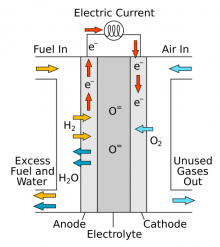If you would like to see more information on this case study, click here!
You can request this case study and a WCDE staff member will get back to you.
 The National Research Council is the government of Canada’s main research and development organization [1]. Daniel Au spent his co-op term working there under the supervision of Dr. Gisele Amow (Defence R&D Canada), performing research on novel cathode materials for intermediate temperature solid oxide fuel cells (SOFCs). Solid oxide fuel cells consist of a cathode, anode, and electrolyte. Originally, they operated at temperatures around 1000ºC, but these high temperatures led to thermal and chemical degradation. Current research focuses on intermediate temperature SOFCs, which operate in the range of 650ºC to 800ºC. Because of the decreased temperature range, there is an opportunity to increase the performance of the cathode material by utilizing materials different from those traditionally used at higher temperatures.
The National Research Council is the government of Canada’s main research and development organization [1]. Daniel Au spent his co-op term working there under the supervision of Dr. Gisele Amow (Defence R&D Canada), performing research on novel cathode materials for intermediate temperature solid oxide fuel cells (SOFCs). Solid oxide fuel cells consist of a cathode, anode, and electrolyte. Originally, they operated at temperatures around 1000ºC, but these high temperatures led to thermal and chemical degradation. Current research focuses on intermediate temperature SOFCs, which operate in the range of 650ºC to 800ºC. Because of the decreased temperature range, there is an opportunity to increase the performance of the cathode material by utilizing materials different from those traditionally used at higher temperatures.
Dr. Amow’s goal was to discover a cathode material better suited to the temperature range of intermediate temperature solid-oxide fuel cells. Daniel’s job was to synthesize and characterize these novel cathode materials.
This case study covers concepts to introduce students to material synthesis. Students at the end of the case should be able to select methods for material characterization based on the requirements of the final application.
If you would like to see more information on this case study, click here!
You can request this case study and a WCDE staff member will get back to you.
Contact Waterloo Cases in Design Engineering
Steve Lambert
Tel: (519) 888-4728
Email: steve@uwaterloo.ca
The University of Waterloo acknowledges that much of our work takes place on the traditional territory of the Neutral, Anishinaabeg and Haudenosaunee peoples. Our main campus is situated on the Haldimand Tract, the land granted to the Six Nations that includes six miles on each side of the Grand River. Our active work toward reconciliation takes place across our campuses through research, learning, teaching, and community building, and is co-ordinated within the Office of Indigenous Relations.